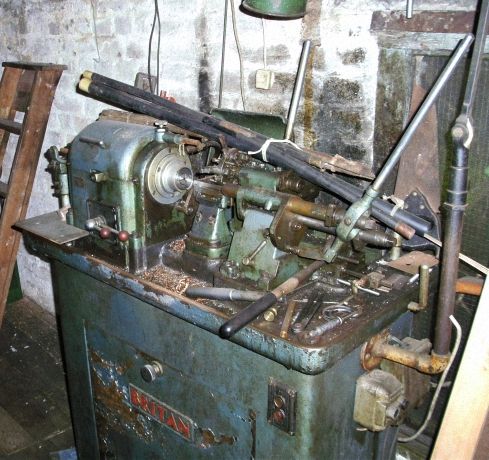I'm happy to carry on a discussion on Britan lathes on the forum. May be I misjudged the potential interest. I don't think the Britan lathe is quite history yet. Internet searches throw up a number of engineering companies who list them as part of their inventory. I doubt they'd list them if they weren't using them.
Here's a first technical question. The lathe uses two types of collet I think.; dead length collets for the stock and smaller clockmaker style collets in the tailstock indexer. My lathe comes with a fair number of collets, but does anyone know if these collets are to a standard design, or did Britan invent their own, proprietry, standard? In other words, is there a possibility I can buy new collets that will fit, or am I stuck with what I've got?
Just to clear up one point. As has been stated the lathe runs in 'reverse' in normal operation with the tool bits behind the work. If you want to turn and drill at the same time then you will need left hand drills. I assume this is one reason the lathes are so fast at production, in that you can have two tools working at the same time. However, if the two operations are carried out separately then normal drills can be used, with the lathe running in a 'conventional' direction. I'm sure somebody will correct me if I've got that wrong. Left hand drills seem to be readily available, albeit at a slight premium in price.
Websnail: When I first spoke to the vendor almost the first thing he said was that it was a 1-1/4" version, so clearly more desirable! Did you set up the lathes as well as operate them? I assume that it's fairly simple, in theory. In practise I assume that there are a lot of trial cuts and adjustments of the screws before operating in anger?
Mike: That's really interesting, I'm always keen to hear stories about working in engineering companies. Can you remember which firm in Bedford made the castings? Bedford is my home town; the only casting company in Bedford that springs to mind was Georg Fischer? As I explained to Mike in my PM I used to work in Poseidon House, on Castle Park in Cambridge, which is exactly where Gloucester Street is shown on my street map of Cambridge. My map must date from 1980, when I first came to live in Cambridge. Sadly the street is no longer marked on current maps. On the corner of what was Gloucester Street is the Isaac Newton pub, which I assume was built around 1990 when Castle Park was developed. Does anyone know if there was a pub there before the redevelopment? I used to drink in the Isaac Newton, before I fell out with the landlord. 
Steve: Interesting picture; I guess the key questions are what collet capacity and how much tooling is available? For anybody thinking of buying, and moving, a Britan, it's quite a small lathe. I measured the footprint of mine at roughly 38" by 24", weight about 1000lbs I'd guess? So, easily moveable with a car and trailer.
Right coffee break over, back to work!
Regards,
Andrew
Anonymous.





